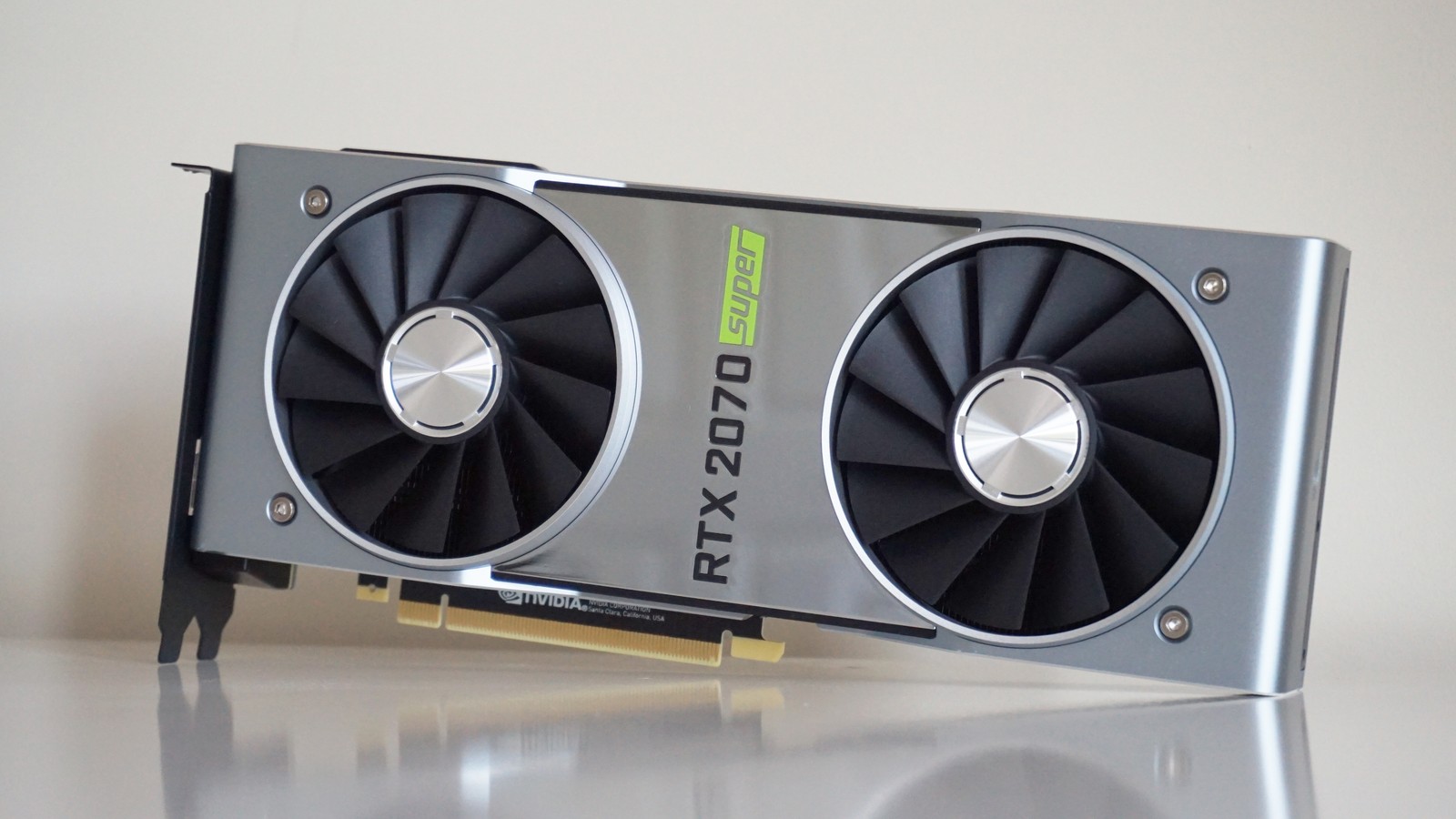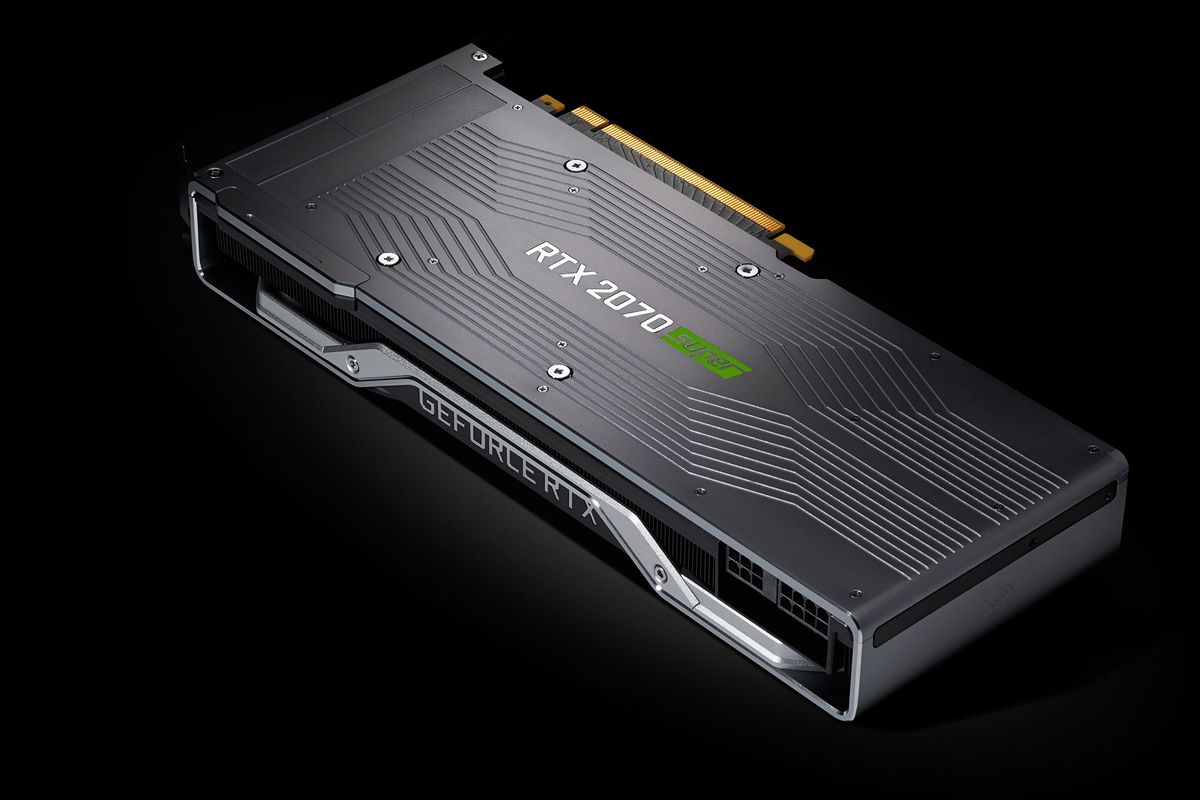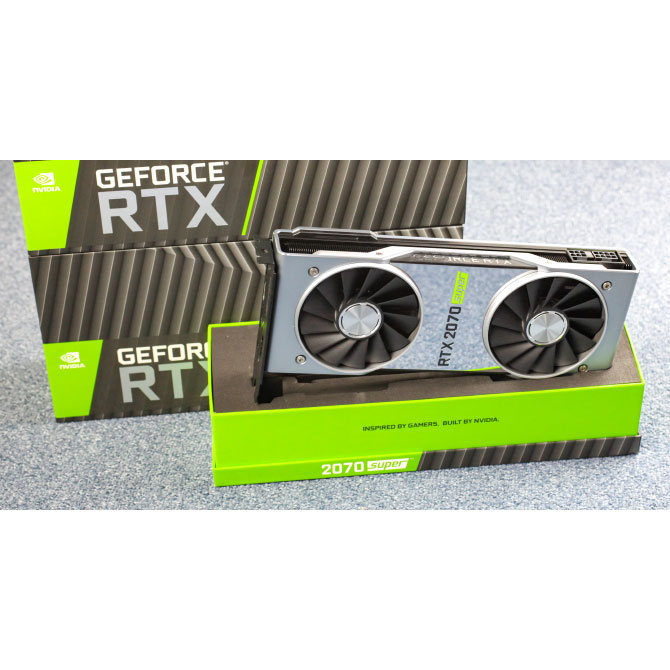Cons
- Only slightly faster than RTX 2070 FE
- Nothing new to see here
- Needs a killer RTX game
The launch of the Nvidia GeForce RTX 2070 Super today was entirely anticipated. AMD’s Navi architecture, along with the Radeon RX 5700 and RX 5700 XT, is set to debut on July 7, positioning itself among the top graphics cards available. AMD asserts that the 5700 XT will outperform the RTX 2070 by approximately 10 percent while being priced. Given that nine months have passed since the initial release of the RTX 2070, it is likely that production yields have improved, providing Nvidia with an incentive to enhance performance. Consequently, the RTX 2070 Super has been introduced, utilizing the TU104 GPU with additional cores and enhanced performance, while maintaining the original starting price for the 2070—eliminating the previous Founders Edition premium.
Setting aside the questionable branding choice (was ‘Super’ truly the most fitting name Nvidia could devise?), there is little new information to convey. The GeForce RTX 2070 Super is built on the same Turing architecture as the current RTX models, and in summary, the addition of more CUDA cores and increased clock speeds results in improved performance compared to the previous RTX 2070. In contrast to the standard RTX 2060, which will continue to be available despite the introduction of the GeForce RTX 2060 Super, the original 2070 and 2080 models are being discontinued. This diminishes the significance of AMD’s reported 10 percent performance lead over the 2070.
The 2060 Super offers the benefit of enhanced memory capacity, thereby increasing bandwidth compared to the standard 2060 model. In contrast, the GeForce RTX 2070 utilizes a fully activated TU106 chip, indicating that Nvidia must seek alternative solutions to boost performance through additional cores. In this context, “alternative solutions” refers to upgrading to the larger TU104 chip, which is also utilized in the RTX 2080.
The GeForce RTX 2070 Super is equipped with 40 streaming multiprocessors (SMs), with each SM comprising 1 RT core, 8 Tensor cores, 4 texture units, and 64 CUDA cores. The FP64 performance is 1/32 of the FP32 performance, consistent with other GeForce RTX models. Essentially, the 2070 Super can be viewed as a scaled-back version of the RTX 2080.
The reference boost clock for the RTX 2070 Super is set at 1770MHz, surpassing the overclocked boost clock of the 2070 Founders Edition, which stands at 1710MHz. This, along with the inclusion of four additional streaming multiprocessors (SMs), suggests a potential performance increase of up to 22 percent compared to the RTX 2070. However, it is important to note that theoretical expectations do not always align with actual performance outcomes. Given that the 2070 Super shares the same memory bandwidth and configuration, the real-world performance enhancement typically ranges between 10 to 15 percent.
The positive aspect is that any additional performance compared to the RTX 2070 is achieved without an increase in cost. The 2070 Super Founders Edition maintains its initial price. While it is true that RTX 2070 cards have been available for as low as in the past nine months, it is likely that the Super cards will eventually be offered at a price lower than their launch cost. Furthermore, the introduction of the 2070 Super signifies the gradual discontinuation of the standard 2070 model. Although these cards may still be available for several months, it is anticipated that the 2070 Super—and the 2080 Super—will ultimately become the sole RTX 2070/2080 models in production, thereby replacing the base models in our top graphics cards list.

The complete specifications for our GPU test bed are available on the right. We utilize a Core i7-8700K overclocked to 5.0GHz to prevent the CPU from becoming a limiting factor during our evaluations. While this is less critical for slower graphics cards, it is essential for high-performance models like the RTX 2070 Super, as we aim to eliminate any potential constraints on the GPU’s performance. Additionally, we employ DDR4-3200 memory and high-speed SSD storage to further enhance system efficiency.
We conducted benchmarking utilizing the most recent drivers available during the testing period, which included re-evaluating older GPUs to confirm the accuracy of our results. All Nvidia GPUs were assessed with the 430.86 drivers, with the exception of the two Super models that were tested using the 431.16 drivers, as it is impractical to retest every GPU with the launch drivers provided by Nvidia due to time constraints. For AMD GPUs, we employed the 19.16.2 drivers.
In my review of the RTX 2060 Super, I mention that although the selection of games I am evaluating has been revised, I am not utilizing DXR or DLSS in any of these benchmarks. This approach is intended to facilitate a significant comparison among the different GPUs, although I have conducted tests on games that support DXR and DLSS in other contexts. Currently, AMD does not offer DXR support through compute shaders, which means that until the release of Navi 20 in the future, Nvidia GPUs are the sole choice for games that utilize DXR technology.
I’m testing with 11 games that include a pretty even mix of AMD and Nvidia promoted titles. DirectX 12 is utilized in most cases, with the exception of Total War: Warhammer 2 where the “DX12 Beta” performance is particularly weak on Nvidia GPUs. Each card is tested at four settings: 1080p medium (or equivalent) and 1080p/1440p/4k ultra (unless otherwise noted). Every setting is tested multiple times to ensure the consistency of the results, and we use the best score. Minimum FPS is calculated by summing all frametimes above the 97 percentile and dividing by the number of frames, so that it gives a reasonable representation of the lower end of the performance scale, rather than looking only at the single worst framerate from a benchmark run.
The following are the results, beginning with 1080p. While this resolution is not typically the primary focus for a graphics card, it facilitates maximizing the performance of a 144Hz monitor more effectively than 1440p does.
Performance of the GeForce RTX 2070 Super.
It is important to mention that my benchmarking has been conducted using Nvidia’s Founders Edition cards for all RTX models. This approach occasionally leads to somewhat unusual results, as the 2070 FE, 2080 FE, and 2080 Ti FE are equipped with a factory overclock of 90MHz. In contrast, the new RTX Super cards operate at reference clock speeds. While it is highly likely that Nvidia’s graphics card partners will release custom Super models with factory overclocks, the performance of the 2070 Super may not significantly exceed that of the 2070, partly due to the overclocking of the 2070 FE.
Aside from the aforementioned disclaimer, the performance aligns closely with expectations. The 2070 Super demonstrates a six percent increase in speed compared to the 2070 Founders Edition at 1080p medium settings; however, numerous games are experiencing CPU bottlenecks. Only the most resource-intensive titles, such as Assassin’s Creed Odyssey, Metro Exodus, and Forza Horizon 4 (which is marginally affected), fail to achieve an average frame rate of 144fps.
The performance at 1080p ultra settings decreases by approximately one-third on average when compared to 1080p medium settings; however, the RTX 2070 Super consistently maintains frame rates above 60fps. Additionally, it outperforms both AMD’s Radeon VII and Nvidia’s GTX 1080 Ti on average. When compared to the 2070 Founders Edition, it exhibits an overall increase in speed of 8 percent, positioning it roughly 15 percent faster than a reference clocked RTX 2070.
The RTX 2070 Super maintains strong performance at 1440p on ultra settings; however, to achieve framerates exceeding 60 in Assassin’s Creed Odyssey, some adjustments to the settings will be necessary. Currently, the 2070 Super is 9 percent faster than the 2070 Founders Edition, yet at this higher resolution, the Radeon VII manages to perform marginally better.
Ultimately, at 4K ultra settings, the performance edge over the 2070 FE rises to 10 percent. In general, the 2070 Super, Radeon VII, and GTX 1080 Ti exhibit comparable performance levels. There are instances where the 1080 Ti outperforms, as well as scenarios where the 2070 Super takes the lead. The distinction largely depends on whether a game is constrained by shader performance or bandwidth limitations.
It is not unexpected that maintaining framerates exceeding 60fps at 4K ultra resolution presents significant challenges; even the Titan RTX and RTX 2080 Ti struggle to achieve this in certain titles. For those who are committed to gaming at 4K, it is advisable to consider utilizing high or even medium settings in some games to ensure a smooth gaming experience.

GeForce RTX 2070 Super: a slight yet appreciated enhancement in performance.
The RTX 2070 Super does not present any significant surprises. By activating additional cores and raising clock speeds, one can achieve enhanced performance. The 2070 Super offers a performance increase of approximately 10-15 percent compared to the standard RTX 2070. Furthermore, it is only 5-10 percent less powerful than the RTX 2080, although the upcoming RTX 2080 Super will alter this comparison in the near future.
The 2070 Super represents an excellent choice for individuals aiming to construct a high-performance gaming PC, particularly in terms of value. It ranks highly in terms of frames per second relative to the overall investment in a complete system. However, when focusing solely on the graphics card, the RTX series and other premium GPUs may appear less appealing. It is important to note that value can be interpreted in various ways; for instance, even a complimentary GTX 650 is unlikely to attract interest from those wishing to engage with the most recent gaming titles.
For individuals who have not yet seen a reason to transition to one of Nvidia’s RTX graphics cards, it is unlikely that the 2070 Super will alter their decision. The focus appears to be less on persuading new users to make an upgrade and more on guaranteeing that Nvidia maintains a competitive edge over AMD’s forthcoming RX 5700 series. However, the performance of the RX 5700 series remains uncertain at this time.
Given that AMD has asserted a 10 percent performance edge over the RTX 2070, it appears that Nvidia will ultimately prevail in terms of performance. Additionally, Nvidia maintains an advantage in power efficiency, although the difference is minimal, with power consumption figures of 215W compared to 225W. The more significant concern lies in the future integration of ray tracing technology in games and game engines. While you may not currently envision a desire to play games with DXR ray tracing effects activated, having that option is available with an Nvidia GPU. In contrast, with an AMD GPU, including the upcoming Navi 10 models, unless AMD revises its stance on DXR driver support, users may find themselves at a disadvantage.
The widespread adoption of ray tracing technology in gaming is likely still several years away; however, the list of forthcoming titles compatible with Nvidia’s RTX graphics cards continues to expand. If you are able to extend the use of your current graphics card for a bit longer, it is generally more advantageous than investing a significant amount of money in an upgrade. When the moment arrives to transition to a new card, there will undoubtedly be options that are superior, more efficient, and/or more cost-effective.
On July 7, we will examine the performance of AMD’s RX 5700 XT and RX 5700 graphics cards, while the RTX 2070 Super and 2060 Super will be available for purchase starting July 9.



